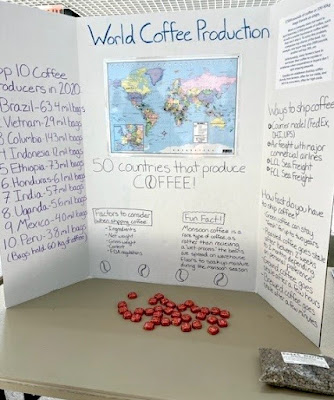A Coffee Maven Brew-At-Home Moment
This semester I was pleased to be able to conclude our Secret Life of Coffee Honors Seminar by hosting class at Cloverfield, a.k.a. Casa Hayes-Boh, a.k.a. our house very close to campus at 41º75’07” N 70º58’31” W.
This allowed us to share old-house stories, Latin American art, and most especially a few coffee tricks that are a bit difficult to try at school. Having been thwarted in various, nearly successful efforts to install a roaster on campus, I roast most of the coffee for this class -- and all of my classes -- in a 1-pound countertop Behmor drum roaster.
Before demonstrating that process, however, I dusted off my vacuum press. It is a crazy-looking contraption, slightly scary to use. But it makes remarkably smooth coffee. Here is a Bodum company demo -- note the preparer's fearless use of long-sleeved, white clothing. I use my vacuum pot so infrequently that I reviewed this video before the students arrived.
They had seen a similar pot in use -- improperly -- in the inadvertently hilarious 1961 video This is Coffee, in which the coffee boils vigorously and dangerously for far too long and is stirred with a metal spoon.
Those who have seen the Coffee Maven in his natural habitat will not be surprised that I neither measured nor stirred the coffee yesterday. Usually I do stir with a wooden chopstick though, as I did both times that I used the pot today.
Thankfully, one of my students took a couple of candid videos of my efforts yesterday -- these are not scripted as instructional, but you can notice a couple details here that you might not see in the Bodum video.
Part 1 (video by Anna Dykhof):
Part 2 (video by Anna Dykhof):
My main motivation for creating this blog post was to share some photos I made during the visit, because of another omission during the brewing process. I forgot to show the students what the filter in this device looks like. In fact, it does not look like a filter at all. I am amazed that it works and even more amazed that someone even thought of this as an option. It is a little bit difficult to describe, but these three photos provide some idea.
First, the overview. This is a plastic disk at one end of a chain with a small spring at the other end. The idea is that the spring holds the disk snugly against the bottom of the "upstairs" part of the brewing vessel.
A close-up of the disk shows that the bottom has a series of very small grooves:
This disk rests against the smooth neck of the brewer. In this photo, I moved the heavy rubber ring down a bit so that the glass can be discerned:
These grooves allow coffee to be drawn down through the neck of the vessel without bringing any grounds at all with it -- as long as a suitable coarse grind has been selected (as it has). Not only does this work, but it does create a very effective filtration and creates a coffee that is full-bodied and smooth. I made a couple pots worth on the day after our class visit.
Roasting
And now, the aforementioned roasting.
 |
| We began with 15.9 ounces of green coffee -- right at the capacity of the Behmor and measuring about 2.5 cups by volume. |
 |
| I placed the coffee in the Behmor's basket. It could hold a lot more of course, but filling the capacity is only about 20 percent of the volume of the basket, because airflow is key to safe and even roasting. |
 |
| The result: 13.5 ounces of coffee (as moisture was driven off during the process) measuring almost 4 cups (as those beans had expanded). The whitish lines on many beans are sugars that are visible at this roast level. |
 |
| Roasting/brewing/tasting some fine coffees left us all smiling! |
 |
| Where does coffee come from? A lot of places, including some that are likely to be surprising. We spent a lot of the semester talking about differences and similarities among coffeelands. |
 |
| Coffee can be brewed in many ways, each with its own appropriate grind level (coarseness/fineness). |
 |
| A bit more detail on the grind options. |







No comments:
Post a Comment